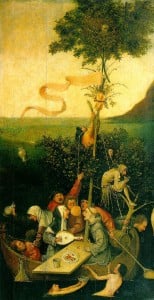Anna Welch highlights another treasure recently put on display for our amusement and improvement…..
Currently on display in Mirror of the World is a 1570 English edition of Sebastian Brant’s famous German satire The Ship of Fools. You can find a recent reprint of this edition in the library’s main collection. The political allegory of the ‘ship of fools’ goes all the way back to Plato. In Book 6 of his Republic (c. 380 BCE), the Greek philosopher likened a democratic state to a ship with a deaf and blind captain: it is vulnerable to mutiny by power-hungry sailors who know nothing of navigation and who will not steer a true course for the vessel, which sails aimlessly round in circles.
By the fifteenth century, this allegory had been adapted for a Christian context. The ‘ship of fools’ became an image of humankind more generally, which travels, seemingly without care, towards a ‘fool’s paradise’ instead of concentrating on attaining God’s heavenly paradise.
Strasbourg-born Brant (1458–1521) was a humanist scholar and staunch German cultural nationalist, who looked to the Holy Roman Empire to protect Western Europe against the invading Ottoman Turks. He died on the cusp of the German Reformation, sparked in 1517 when Martin Luther famously nailed his 95 Theses to the door of Wittenberg’s church. Brant’s poem (in which a shipload of idiots sail for Narragonia, or ‘fool’s paradise’) describes many human follies and vices as a warning to the general public to mend their ways, both spiritual and political.
Originally published in German as Das Narrenschiff in 1494, then translated into Latin and embellished by Jacob Locher in 1497, Sebastian Brant’s Ship of Fools was a bestseller of its day. It appeared in no fewer than 15 editions before the end of the fifteenth century. The bizarre and often humourous woodcuts (including a frontispiece by Albrecht Dürer) that accompanied each edition of Brant’s work contributed greatly to the popularity and influence of the text. Brant’s contemporary Hieronymus Bosch (c. 1450–1516) had most likely seen this illustrated book before painting his famous altarpiece triptych of c. 1490–1500, which includes a panel depicting a Ship of Fools. The allegory of the Ship of Fools continues to inspire artists, writers and musicians to the present day.
Sebastian Brant’s book will be on display until September 2015.
Anna Welch
History of the Book
A different take on the ship of fools, as performed by John Renbourn and his lively crew; courtesy of the Alexander Street Press database






